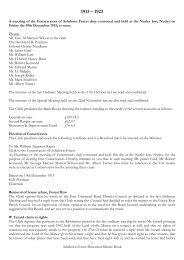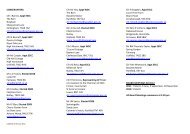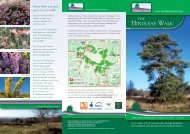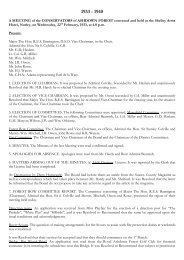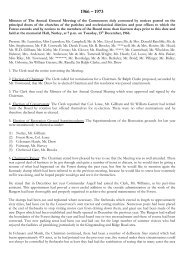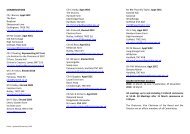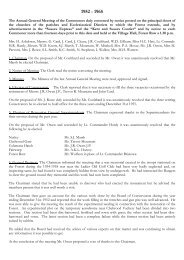Military_Walk_Archae.. - Ashdown Forest
Military_Walk_Archae.. - Ashdown Forest
Military_Walk_Archae.. - Ashdown Forest
You also want an ePaper? Increase the reach of your titles
YUMPU automatically turns print PDFs into web optimized ePapers that Google loves.
A short distance further on 9 you will see to your left the<br />
Guard House for the Kingstanding broadcasting transmitter,<br />
which was constructed in 1941 and continued to operate until<br />
1982. At the side of the road there are numerous concrete<br />
anti-tank pimples, not for stopping German tanks, but to<br />
keep Allied tanks off vulnerable areas during training!<br />
Continue on the track. <strong>Walk</strong> past Camp Hill on the left side of<br />
the concrete pillar (trig point), and continue straight on, then<br />
take the left fork in the track after 30m 10 .<br />
A concrete hump with an anti-tank pimple hidden in the gorse<br />
at each end marks an entrance into the training area for tanks,<br />
and also protects a wartime underground power cable to<br />
Kingstanding from damage.<br />
Return to the trig point and turn left, passing Camp Hill clump<br />
on your right and then heading downslope on the broad track<br />
with Old Lodge House straight ahead of you.<br />
As you head down the slope 11, there are more First World<br />
War practice trenches and Second World War slit trenches in<br />
the gorse and bracken on both sides. In the valley to your right<br />
is a line of at least 16 field kitchens from 1793.<br />
Pass the clump of silver birch trees on the right, where the<br />
slope levels out, and immediately turn left 12 to follow the<br />
track with Friends Clump ahead of you. Follow the track down<br />
and round to the left ignoring the path on your right. After a<br />
further 150m turn right taking a minor track to cross the valley<br />
and stream by a small pond 13.<br />
Climb up the slope to Box car park and turn right to follow the<br />
track straight up the hill ahead to return to Friends Clump 1 .<br />
HISTORY &<br />
ARCHAEOLOGY SERIES<br />
<strong>Ashdown</strong> <strong>Forest</strong> is a former medieval hunting forest: the largest of four<br />
spread between Horsham and Tunbridge Wells in an area known as the<br />
Weald <strong>Forest</strong> Ridge. This is the highest ridge of the High Weald, itself<br />
recognised as one of England's Finest Landscapes and designated<br />
as an Area of Outstanding Natural Beauty (AONB).<br />
At 2,500 hectares (10 square miles), <strong>Ashdown</strong> <strong>Forest</strong> is the largest open<br />
access space in the South East. Nearly two thirds of it is heathland, one<br />
of the rarest habitats in Britain.<br />
Use your smartphone to scan the code for more information.<br />
You can also find out more about the<br />
archaeology and history of <strong>Ashdown</strong> <strong>Forest</strong><br />
by visiting www.ashdownforest.org and the<br />
<strong>Ashdown</strong> <strong>Forest</strong> Centre at Wych Cross.<br />
THE MILITARY<br />
ON THE FOREST<br />
HISTORY &<br />
ARCHAEOLOGY SERIES<br />
Looking towards Friends Clump<br />
THE CONSERVATORS<br />
OF ASHDOWN FOREST<br />
Concept and production co-ordination: Paul Cooper: forest.marketing@btinternet.com<br />
Editorial and research: Chris Butler and Vivienne Blandford: www.cbasltd.co.uk<br />
Design and print production: Matt Marriott: m.marriott@btconnect.com<br />
Cartography: Dave Brooker: dave@mappingideas.co.uk<br />
Photography: Simon Aguss, High Weald AONB Unit, Vivienne Blandford, Chris Butler, Paul Cooper.<br />
All details are believed correct at time of production but we cannot accept responsibility for any errors or omissions.<br />
EXPLORING ASHDOWN FOREST ON FOOT - WALK 13<br />
A circular walk with some uphill sections<br />
over heather-clad heathland, with splendid<br />
views across the central part of <strong>Ashdown</strong> <strong>Forest</strong>.
HISTORY & ARCHAEOLOGY SERIES<br />
THE MILITARY ON THE FOREST<br />
WALK 13<br />
3.5 miles/6km<br />
Park in Friends car park 1 , opposite Stonehill car park.<br />
<strong>Walk</strong> out of the back of the car park towards the pine trees<br />
of Friends Clump and then around its left side.<br />
The shallow zig-zag depressions in the ground here are filled-in<br />
First World War practice trenches. Soldiers dug these<br />
during training exercises.<br />
<strong>Walk</strong> on past the Clump towards the seat, and continue<br />
downslope. After 50m turn right into a cleared area 2 .<br />
Scattered around the cleared area and in the gorse to your left<br />
are numerous Second World War slit trenches. About 70m<br />
ahead is a small bracken-covered mound, the remains of<br />
a field kitchen from a vast 1793 military camp.<br />
About 20m before you get to the field kitchen take a minor<br />
path which bends left down through the gorse, heading<br />
towards the radio mast on the skyline. When this meets<br />
a major track turn right and continue for another 50m 3 .<br />
You will come to three circular field kitchens: a very damaged<br />
one on the track; one beside the track on the right;<br />
and another, gorse covered, a short distance to<br />
the left. <strong>Archae</strong>ologists have found a ditch<br />
and numerous small ovens cut into these.<br />
Turn around and head downslope on a grassy track with Old Lodge<br />
House on the skyline ahead. At the bottom of the hill turn right<br />
across the stream, and then head upslope following the track and<br />
keeping the wood on your left.<br />
Just after crossing a wooden bridge (700m) you will see three<br />
gorse-covered mounds on the skyline on the right 4 . These are<br />
the firing points of a First World War firing range, which were<br />
spaced at 100 yard (91m) intervals. As you approach these on<br />
the track, look to your left where there is another adjacent to the<br />
track, and then another 100 yards further on. The butts are<br />
hidden in the trees beyond. A second firing range is located<br />
another 200m further on.<br />
Continue up the track for about 400m. Just before a gate turn right<br />
on a path with Camp Hill clump on the skyline ahead. After 50m<br />
turn left 5 and follow a grass track parallel to the road towards<br />
Bushy Willow car park. After 50m 6 you cross a faint disused road,<br />
possibly Roman in origin, slightly sunken with banks along each side.<br />
Continue past the car park, and then parallel to the road with the<br />
radio mast ahead. The track 7 then bends right with Camp Hill on<br />
the skyline ahead.<br />
After you pass a clump of trees on your right and draw level with the<br />
mast on your left, turn left to reach Roman Road car park 8 where<br />
you will find a section of exposed Roman Road. Return to the track<br />
and head towards Camp Hill.<br />
Contains Ordnance Survey data © Crown copyright and database right 2012<br />
and data © OpenStreetMap contributors CC-BY-SA<br />
First World War practice trenches A partly excavated field kitchen Second World War tank traps<br />
The military camp of 1793 Roman Road



